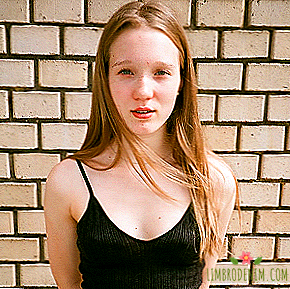Instagram editor on how mobile photography has changed the world
Social networks are already For a long time, not only a means of communication and socialization is a powerful tool that affects our perception of ourselves and the world, and not least through the use of photographs. We talked about this with Kristen Joy Watts - one of the founders of the famous photoblog "Lens" on The New York Times, and now the head of the editorial board in the field of art and fashion on Instagram. Kristen told how mobile photography has changed our lives, why people photographed food, when only film cameras were in use, and how to become famous using Instagram if you are a young artist or photographer.

 Before becoming the editor of Instagram, you managed to work in the mass of interesting projects, and the most striking, perhaps, was the launch of the photo blog The New York Times.
Before becoming the editor of Instagram, you managed to work in the mass of interesting projects, and the most striking, perhaps, was the launch of the photo blog The New York Times.
Yes, "Lens" was my first project. And it was a very cool start. In a sense, it was a startup, so you can say that I now have experience working with startups. At the same time, I was part of a great history and a big organization and got the opportunity to work with some of the best journalists in the world. In one of the projects for "Lens", we invited readers to send us one of their favorite Polaroid, in the other - to take a photo at the same time and send it to us. The last project was called "A Moment in Time". People from all over the world sent photos taken at three in the afternoon UTC, and our team turned them into graphics, so that all the pictures could be seen on the globe. As a result, on some photos it was still dark, on others - the middle of the working day, and all this happened in the world at the same time. We did "A Moment in Time", it seems, in 2010, even before instagram and the explosion of the popularity of mobile photography. Then we wanted to show that anyone can be a photographer. In "Lens" it was very cool to work.
Later, I did a workshop on photography for children and accidentally met a person there who invited me to an R / GA advertising agency. It was also a very interesting experience. At the same time I did the project "The Weight of Objects" - photo stories of people told through one most valuable thing for them. We didn’t finish it that way - officially, I mean. He just logically came to an end.
 "The Weight of Objects" is a very beautiful project - both aesthetically and philosophically. How did you come up with it?
"The Weight of Objects" is a very beautiful project - both aesthetically and philosophically. How did you come up with it?
Surprised that you know about him. At that time, I was incredibly inspired by the photographer Ramsay de Giv. I left The New York Times then, I worked at R / GA, and in general I was interested, but I didn’t have enough of what I did in The New York Times, I wanted to edit photos. Well, I wanted to experiment with different ways to visually tell stories. And so appeared "The Weight of Objects".

One of the nicest parts of my job is to draw attention to talented people and do something good for the community as a whole.

 How did you end up on Instagram?
How did you end up on Instagram?
I spoke at the SXSW festival, we discussed with various experts the growing popularity of mobile photography. One of the experts was Kevin Sistrom, co-founder of Instagram, so after the conference we started working with him. I remember well that the topic of that discussion was: “What does our obsession with photography lead to — mediocrity or magic?”
 And what is the answer? What happens magic or mediocrity?
And what is the answer? What happens magic or mediocrity?
At the discussion, we did not come to a single decision, but my answer is, of course, magic. Working in The New York Times, I saw with my own eyes a huge number of excellent shots taken on the phone, and watched how mobile photography becomes incredibly popular - this is exactly magic.
 are you still taking pictures of food?
are you still taking pictures of food?
Occasionally. Sometimes I just eat a very beautiful meal. So if I get a beautiful picture, I even feel proud.
 Tell us exactly what you do on Instagram. What does your average working day look like?
Tell us exactly what you do on Instagram. What does your average working day look like?
It is quite difficult to describe. Every day at work is completely different from the other, and I really like it. In general, I do everything that needs to be done. If you need to order food or brainstorm, to come up with a hashtag for the event - then I will order food and brainstorm. But I usually work on one or two stories for our editorial accounts such as Instagram. I am interviewing someone or editing photos with our editor-in-chief Pamela Chen. She came to Instagram from National Geographic, and she's awesome.
Overall, Instagram tries to stay behind the scenes. We want everyone who wants to do some cool projects with us or our community, not think that they have to become our advertising partners in order to do something cool. We really want cultural institutions, fashion houses, bloggers themselves to create their own communities. So that people themselves find instagramers that they like and with whom they want to work. I think this is much more honest and much more interesting in a creative sense. Often, event organizers invite people we did not even think about or did not know before.
 Which of the projects on which you worked on Instagram did you remember most?
Which of the projects on which you worked on Instagram did you remember most?
Oh, I participated in so many cool projects. From the last - for the Paris fashion week, we worked with illustrator Soledad Bravy. She has a terrific blog. We wanted to create a map of Paris, show it through the eyes of instagramers. As a result, she drew not just a map - she found people who wrote in their instagrams about Parisian places, painted these places, and nearby - instagramers themselves, taking photos of the mentioned place. This card was distributed free of charge at Fashion Week, it was such a gift to the community. For Soledad, we arranged something like an autograph session: she is very shy, but agreed to sign the cards. As a result, the event, calculated for half an hour, stretched for two whole, a huge queue lined up, and then Karl Lagerfeld came at all. They met Soledad, she immediately drew it on the map, she was trembling with delight and was incredibly happy. This is one of the nicest parts of my work — to draw attention to talented people, such as Soledad, and to do something good for the community as a whole.
 Does Instagram somehow help young artists? you are just doing what you are looking for accounts of talented people who are associated with fashion or art, right?
Does Instagram somehow help young artists? you are just doing what you are looking for accounts of talented people who are associated with fashion or art, right?
Yes, everything is so, we regularly talk about such heroes. One of my favorites has recently appeared on a blog - this is 16-year-old Hayley Connolly, who paints portraits of her subscribers and her favorite celebrities. In Instagram, illustrators often become famous because of this — the stars repost their drawings. For example, Lupita Nyong'o recently secured her very cool pencil portrait.
Actually, I really like the fact that on Instagram, people not only share what they have always done, but also try something new. For example, Hans Ulrich Obrist, curator of the Serpentine Gallery in London, recently launched a project on handwriting: he will post photographs of notes of various people. Here such things always make me very happy.

Each of us today is a little photographer, a little editor and a little model. But the reality is different from the reality of our photos.

 And who, besides you, does the Instagram blog?
And who, besides you, does the Instagram blog?
In total, our blog has nine editors living all over the world - in Tokyo, Moscow, and London. I only do fashion and art, but most editors are responsible for their region. I admire them, because, in fact, they need to understand everything at the same time. We organize meetings on Skype, present our ideas to Pamela Chang. Sometimes she gives specific tasks. For example, recently asked me to find someone very cool, who is engaged in fashion and lives in Jakarta. In general, I really want to find a person who, I don’t know, has eighty subscribers and who does something incredibly cool, but no one knows about him yet.
 So far this has not happened?
So far this has not happened?
Well, for example, last week I met a woman who opens a gallery in Kazakhstan, and this is the first gallery in the city where she lives. I will definitely follow the fate of the gallery and its personal.
 When social networks were just gaining popularity, many believed that this would change how the media represented us and our bodies — especially women. And that we can see people as they are. Do you think these hopes came true?
When social networks were just gaining popularity, many believed that this would change how the media represented us and our bodies — especially women. And that we can see people as they are. Do you think these hopes came true?
There is such a moment: with the advent of social networks, we have all become more sophisticated and complex. Each of us today is a little photographer, a little editor, a little model, and this is, on the one hand, cool. But the reality as it is is different from the reality that we photograph and edit. Social networks have given us the opportunity to feel that we are all people, that celebrities are the same people as we are, but at the same time we ourselves in social networks tell stories about ourselves rather than show our real life. It seems to me that the closer your story is to the truth, the more people like you. However, the audience is different: someone wants the perfect picture, but someone is interested in the truth.
Photographer: Yegor Slizyak




